Return to Naval Historical
Center home page.  Return to Online
Library listing
Return to Online
Library listing
DEPARTMENT OF THE NAVY -- NAVAL HISTORICAL CENTER
805 KIDDER BREESE SE -- WASHINGTON NAVY YARD
WASHINGTON DC 20374-5060
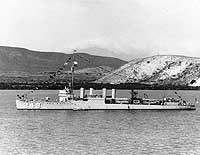
Online Library of Selected Images:
-- U.S. NAVY SHIPS --
USS Barry (DD-248, later APD-29), 1920-1945
USS Barry, a 1190-ton Clemson class destroyer
built at Camden, New Jersey, was commissioned in late December
1920. After nearly a year in reserve status, she entered active
service with the Atlantic Fleet in November 1921. With the exception
of a deployment to the Mediterranean area in 1922-1923 and some
months of operations in the Pacific during 1925 and 1932, the
destroyer spent her first dozen years in the Western Atlantic
and Caribbean, primarily as a unit of the Scouting Fleet. In July
1933, Barry was transferred to San Diego, California, and
for the rest of the decade her base alternated beween the two
U.S. coasts.
As the international situation became increasingly grave in
the Autumn of 1940, Barry was assigned to the defenses
of the Panama Canal area, remaining there until after the United
States entered World War II in December 1941. She served on convoy
escort duties in the Caribbean and South Atlantic into mid-1943,
then became part of an anti-submarine task force built around
the escort aircraft carrier Card (CVE-11). During its two
North Atlantic cruises, between July and November 1943, this group
sank eight German U-boats, greatly contributing to Allied victory
in the Battle of the Atlantic.
At the end of 1943, Barry began conversion to a high-speed
transport and was reclassified APD-29 in January 1944. Following
these modifications and amphibious training, she steamed to Algeria
in April 1944 to prepare for further operations. Barry
participated in the Southern France landings in August 1944 and
spent the rest of the year on escort work in the western Mediterranean.
She was then ordered to the Pacific to take part in the war against
Japan. In mid-May 1945, the ship entered the campaign to secure
Okinawa. While on patrol off that island on 25 May, Barry
was gravely damaged by a suicide plane. Though towed into port,
her wounds were too serious to justify repair. She was decommissioned
a few weeks later. On 21 June 1945, USS Barry's unmanned
hulk was sunk by Kamikaze attack while under tow on a mission
to divert enemy suicide pilots from more valuable targets.
USS Barry was named in honor of Commodore
John Barry (1745-1803), one of the most important leaders
of the early United States Navy.
This page features, or provides links to, all the views
we have related to USS Barry (DD-248, later APD-29).
For other pictures related to this ship, see:
USS Barry (DD-248, later
APD-29) -- During World War II; and
USS Barry (DD-248) -- Under
Construction.
Click on the small photograph to prompt
a larger view of the same image.
Photo #: NH 56355
USS Barry (DD-248)
At anchor, circa the 1920s or 1930s.
U.S. Naval Historical Center Photograph.
Online Image: 73KB; 740 x 595 pixels |
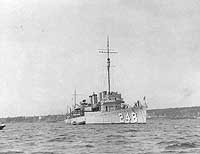 |
Photo #: NH 52423
USS Barry (DD-248)
Photographed in March 1928.
U.S. Naval Historical Center Photograph.
Online Image: 75KB; 740 x 585 pixels |
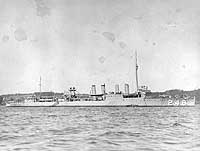 |
Photo #: NH 64560
USS Barry (DD-248)
In Guantanamo Bay, Cuba, during the late 1920s or early 1930s.
Donation of Franklin Moran, 1967.
U.S. Naval Historical Center Photograph.
Online Image: 78KB; 740 x 605 pixels |
 |
Photo #: NH 73277
USS Barry (DD-248)
In San Diego harbor, California, about 1930.
Ships in the right background are USS Kane (DD-235) and
USS Fox (DD-234).
U.S. Naval Historical Center Photograph.
Online Image: 103KB; 740 x 600 pixels |
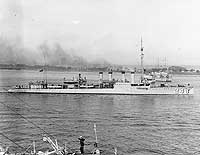 |
Photo #: NH 56349
USS Barry (DD-248)
Off Gonaives, Haiti, circa the 1930s. She is dressed with flags
for some special occasion.
Courtesy of Donald M. McPherson, 1966.
U.S. Naval Historical Center Photograph.
Online Image: 112KB; 740 x 600 pixels |
 |
Photo #: NH 73284
USS Barry (DD-248)
Nested with other destroyers in San Diego harbor, California,
circa 1932-1935.
Two fuel oil barges are moored alongside Barry.
The airship in the distance is either USS Akron (ZRS-4)
or USS Macon (ZRS-5).
U.S. Naval Historical Center Photograph.
Online Image: 72KB; 740 x 605 pixels |
 |
Photo #: NH 56350
USS Barry (DD-248)
Photographed circa the 1920s or 1930s. Several merchant vessels
are in the distance.
U.S. Naval Historical Center Photograph.
Online Image: 68KB; 740 x 520 pixels |
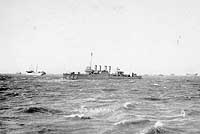 |
The following photographs show USS Barry (DD-248)
with groups of other ships, or in the background of views of other
subjects:
Photo #: NH 91987
Destroyers moored at San Diego, California, prior to World War
II
These ships are (from left to right): USS Barry (DD-248);
USS Bainbridge (DD-246); USS Reuben James (DD-245);
USS Williamson (DD-244); USS Fox (DD-234); USS
Lawrence (DD-250); and USS Hovey (DD-208).
Courtesy of the U.S. Naval Institute Photo Collection.
U.S. Naval Historical Center Photograph.
Online Image: 87KB; 740 x 575 pixels |
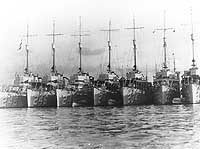 |
Photo #: NH 65026
Battle Force and Scouting Force destroyers
"Full-dressed" with flags in honor of Navy Day while
moored at Balboa, Panama Canal Zone, 27 October 1934.
USS Truxtun (DD-229) is in the left foreground. Nearest
ship in the left center background is USS Barry (DD-248).
Donation of Franklin Moran, 1967.
U.S. Naval Historical Center Photograph.
Online Image: 112KB; 740 x 605 pixels |
 |
Photo #: NH 69160
Hawaiian Maneuvers, 1925
"A number of destroyers and other craft taking up their
positions for additional maneuvers as the Pacific Battle Fleet
steamed out of Honolulu, 20 May 1925" (quoted from the original
caption).
USS Parrott (DD-218) is in the center. Nearest ship at
left is USS Barry (DD-248).
Courtesy of the San Francisco Maritime Museum, 1969.
U.S. Naval Historical Center Photograph.
Online Image: 66KB; 740 x 610 pixels |
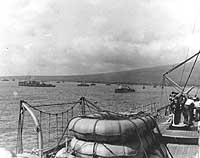 |
Photo #: NH 52463
USS Dallas (DD-199)
Photographed during the Presidential Naval Review, 4 June 1927.
USS Barry (DD-248) is in the left distance. Ship at right
is an Omaha class light cruiser.
U.S. Naval Historical Center Photograph.
Online Image: 63KB; 740 x 540 pixels |
 |
Photo #: NH 99559
USS Williamson (DD-244) and
USS Hovey (DD-208)
In the Miraflores Locks of the Panama Canal, during the 1930s.
Destroyers next astern appear to be USS Barry (DD-248)
and USS Long (DD-209).
U.S. Naval Historical Center Photograph.
Online Image: 109KB; 740 x 615 pixels |
 |
For other pictures related to this ship, see:
USS Barry (DD-248, later
APD-29) -- During World War II; and
USS Barry (DD-248) -- Under
Construction.
For a portrait of Commodore John Barry that was presented
to USS Barry (DD-248) by artist Albert Rosenthal in 1920,
see: Photo # NH 51521.
 Return to Naval
Historical Center home page.
Return to Naval
Historical Center home page.
Page made 8 September 2002
New image added 26 September 2004
